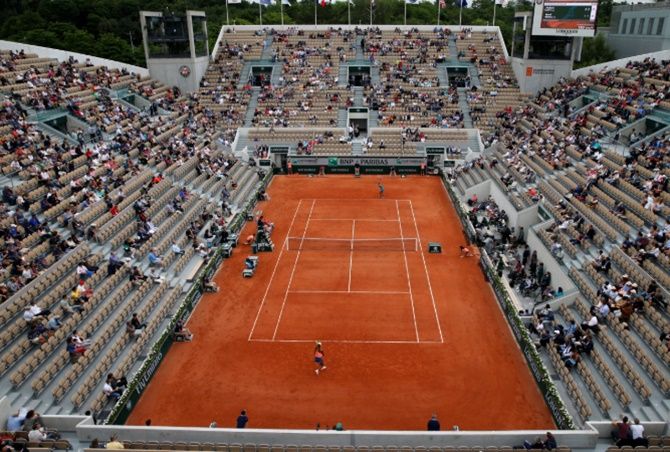'When they started this morning on Suzanne Lenglen, it was almost completely empty. It's really a shame'

The sun had broken through the clouds, the coin had been flipped and the players were ready to begin their third round matches at Roland Garros just after 11 o'clock on Friday morning. The only question was, where were the crowds?
It's been an issue at the French Open for years -- half empty stadiums early in the day, particularly for women's matches, despite the event supposedly being all but sold out -- yet Friday looked to be an especially lacklustre start.
On Philippe Chatrier, the equivalent of Wimbledon's Centre Court, the lower rung of the 15,000-seater stadium -- where many sponsors have hospitality seating -- was all but empty as second seed Alexander Zverev and 24th seed Damir Dzumhur took to the court for what turned into an electrifying five-setter.
The situation was even worse on Suzanne Lenglen, the No 2 court, where American 13th seed Madison Keys took on Japan's exciting talent Naomi Osaka, winning after a tight second-set tie break.
"It's abysmal," said Penny Lincoln, a British woman visiting the French Open for the first time.
"When they started this morning on Suzanne Lenglen, it was almost completely empty. It's really a shame. Whoever was supposed to be there missed a good game."
Her friend Liz Warwick pointed out that the problem seemed to be most serious in the lower tier of the 10,000-seater arena. That's where sponsors and big corporates often block-reserve expensive seats to entertain clients.
"It's not like this at Wimbledon," said Warwick. "At the end of the day, I'd feel really irritated if I'd got a general access ticket but couldn't get to see the big matches even though I could see on the screens that the stadium was nearly empty."
The French Tennis Federation has been trying to tackle the problem in various ways for years, aware that it doesn't feel great for the players or look very good on television when the stands have only a few hundred spectators in them, at least at the start of the day.
Last year, organisers split the tickets on men's semi-finals day so that one would have to buy a ticket either for the first semi or the second, rather than have a whole-day pass.
The aim was to prevent the mass exodus of spectators that usually happens around lunchtime.
While le dejeuner is an institution in Paris, it has a tendency to run from 1230 until around 3 p.m. At Roland Garros, it's often a gourmet meal accompanied by champagne. Corporate clients find themselves drawn to the generously laid table at Le President's Club rather than the exchanges on court.
This year, organisers took further steps, allowing sponsors to invite more than one guest per seat in the stadium, the idea being that while one guest might be munching on terrine with a glass of sauvignon blanc, another could be watching a match.
But it doesn't seem to have had the desired effect, at least not so far.
The oddity is that numbers for the French Open keep on climbing. Last year, there were a record 470,000 visitors over 15 days, almost on a par with Wimbledon, where there were 473,000 spread over 13 days.
On Thursday, 34,400 spectators entered the Roland Garros grounds, in the leafy southwest of Paris, a healthy number that implies another record turnout this year if sustained.
But many of them hold tickets for the outside courts, where seats can be taken on a 'first come, first served' basis.
For the show courts, there's no access without the right, higher-priced ticket. On Friday, last-minute seats were available on Philippe Chatrier for 145 euros a piece, but Suzanne Lenglen and the third-biggest court, which seats 3,800, were apparently sold out.
Asked if they had any new ideas for how to fill up the stadiums early in the day, the French Tennis Federation said they would get back. Online, tennis fans expressed frustration that the players weren't getting better crowds.
"Let the children come," said one tennis fan on Twitter.












